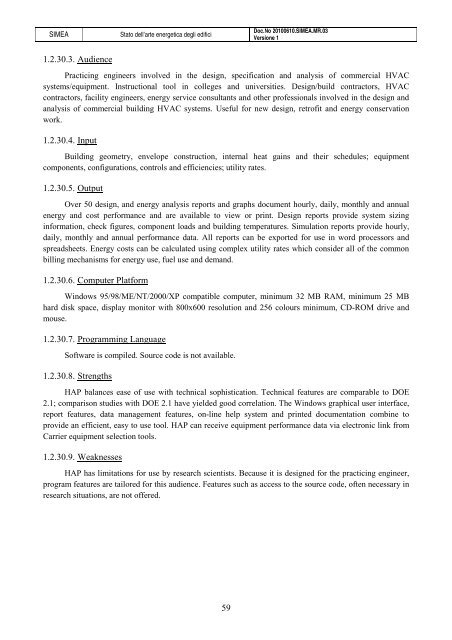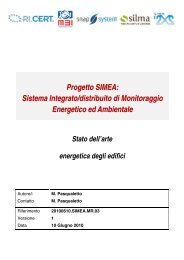Progetto SIMEA - Automatica - Università degli Studi di Padova
Progetto SIMEA - Automatica - Università degli Studi di Padova
Progetto SIMEA - Automatica - Università degli Studi di Padova
You also want an ePaper? Increase the reach of your titles
YUMPU automatically turns print PDFs into web optimized ePapers that Google loves.
<strong>SIMEA</strong> Stato dell’arte energetica <strong>degli</strong> e<strong>di</strong>fici<br />
1.2.30.3. Au<strong>di</strong>ence<br />
59<br />
Doc.No 20100610.<strong>SIMEA</strong>.MR.03<br />
Versione 1<br />
Practicing engineers involved in the design, specification and analysis of commercial HVAC<br />
systems/equipment. Instructional tool in colleges and universities. Design/build contractors, HVAC<br />
contractors, facility engineers, energy service consultants and other professionals involved in the design and<br />
analysis of commercial buil<strong>di</strong>ng HVAC systems. Useful for new design, retrofit and energy conservation<br />
work.<br />
1.2.30.4. Input<br />
Buil<strong>di</strong>ng geometry, envelope construction, internal heat gains and their schedules; equipment<br />
components, configurations, controls and efficiencies; utility rates.<br />
1.2.30.5. Output<br />
Over 50 design, and energy analysis reports and graphs document hourly, daily, monthly and annual<br />
energy and cost performance and are available to view or print. Design reports provide system sizing<br />
information, check figures, component loads and buil<strong>di</strong>ng temperatures. Simulation reports provide hourly,<br />
daily, monthly and annual performance data. All reports can be exported for use in word processors and<br />
spreadsheets. Energy costs can be calculated using complex utility rates which consider all of the common<br />
billing mechanisms for energy use, fuel use and demand.<br />
1.2.30.6. Computer Platform<br />
Windows 95/98/ME/NT/2000/XP compatible computer, minimum 32 MB RAM, minimum 25 MB<br />
hard <strong>di</strong>sk space, <strong>di</strong>splay monitor with 800x600 resolution and 256 colours minimum, CD-ROM drive and<br />
mouse.<br />
1.2.30.7. Programming Language<br />
Software is compiled. Source code is not available.<br />
1.2.30.8. Strengths<br />
HAP balances ease of use with technical sophistication. Technical features are comparable to DOE<br />
2.1; comparison stu<strong>di</strong>es with DOE 2.1 have yielded good correlation. The Windows graphical user interface,<br />
report features, data management features, on-line help system and printed documentation combine to<br />
provide an efficient, easy to use tool. HAP can receive equipment performance data via electronic link from<br />
Carrier equipment selection tools.<br />
1.2.30.9. Weaknesses<br />
HAP has limitations for use by research scientists. Because it is designed for the practicing engineer,<br />
program features are tailored for this au<strong>di</strong>ence. Features such as access to the source code, often necessary in<br />
research situations, are not offered.
















